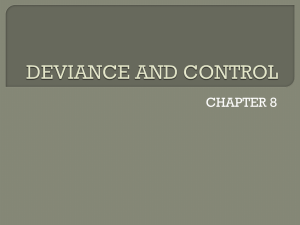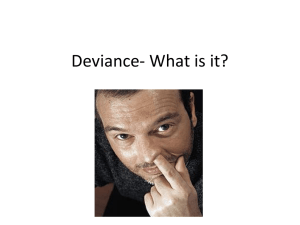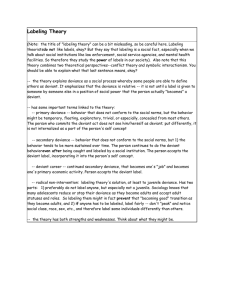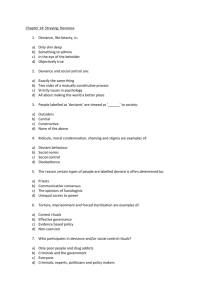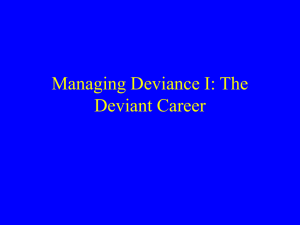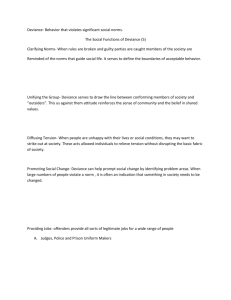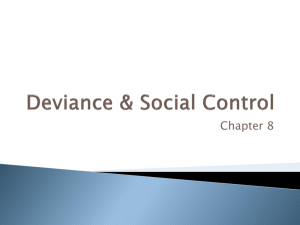CRIMINOLOGY QUIZ 1B Each of the following questions is worth 3
advertisement
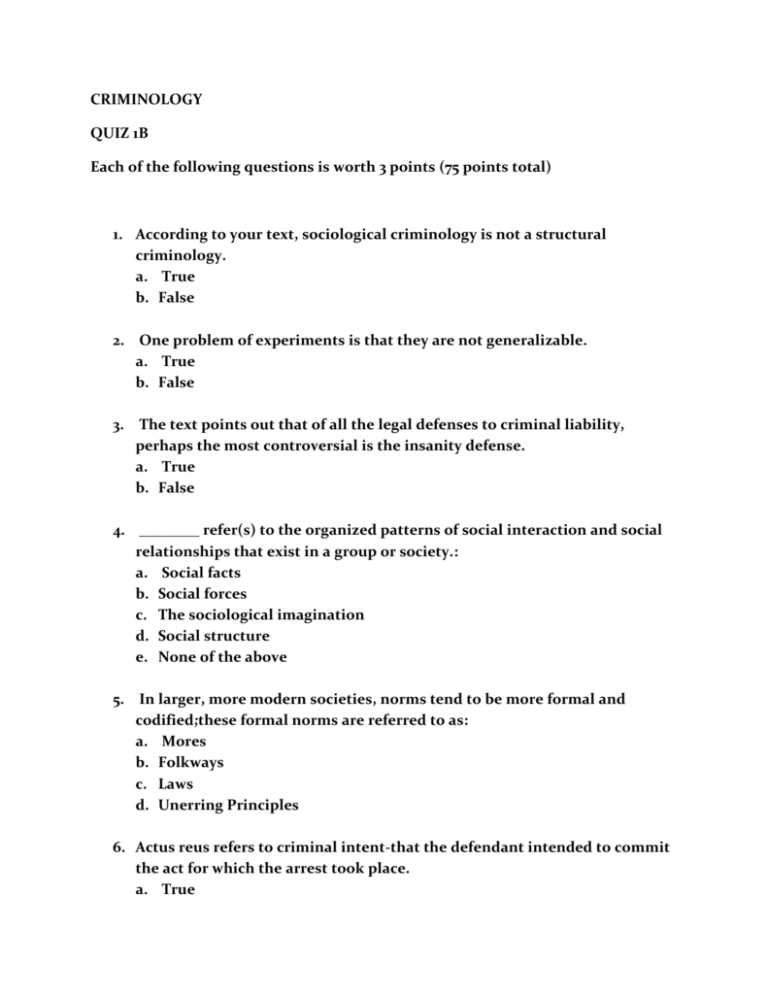
CRIMINOLOGY QUIZ 1B Each of the following questions is worth 3 points (75 points total) 1. According to your text, sociological criminology is not a structural criminology. a. True b. False 2. One problem of experiments is that they are not generalizable. a. True b. False 3. The text points out that of all the legal defenses to criminal liability, perhaps the most controversial is the insanity defense. a. True b. False 4. ________ refer(s) to the organized patterns of social interaction and social relationships that exist in a group or society.: a. Social facts b. Social forces c. The sociological imagination d. Social structure e. None of the above 5. In larger, more modern societies, norms tend to be more formal and codified;these formal norms are referred to as: a. Mores b. Folkways c. Laws d. Unerring Principles 6. Actus reus refers to criminal intent-that the defendant intended to commit the act for which the arrest took place. a. True b. False 7. At one point, anomie theory fell out of favor and in its place rose a new control theory of criminal behavior that emphasized the criminogenic effects of weak bonds to social institutions. a. True b. False 8. C. Wright Mills emphasized that what people may define as private troubles are often more accurately described as: a. Public issues b. Imaginary social forces c. A profound wisdom d. Inconvenient facts 9. Deviance is a/an _____________ concept. a. Absolute b. Psychological c. Eccentric d. Relative 10. The familiar Gallup Poll is a __________ sample of the adult population of the United States, allowing for generalization of the results to the population. a. Partial b. Structure c. Non-random d. Random 11. According to Robert Merton’s strain theory, deviant behavior arises from social realities in which few opportunities or “means” to an end exist to achieve cultural goals. a. True b. False 12. According to this theoretical perspective, what we understand to be deviant is nothing more than a function of perspective. a. Functionalism b. Conflict theory c. Symbolic interactionism 13. The term stigma refers to a culturally positive label that greatly enhances and shapes ones self-concept/identity. a. True b. False 14. Which of the following is not one of the four types of social control referenced in Travis Hirschi’s control theory? a. Belief b. Attachment c. Involvement d. Opportunity e. Integration 15. Labeling theory focuses on the process of learning deviance from family, peers, fellow employees, political organizations, gangs etc… a. True b. False 16. Differential Association theorists define 2 stages in the process of becoming a deviant: Primary deviance-a violation of a norm that may be an isolated event, and Secondary deviance-continuing to violate a norm and taking on a deviant identity. a. True b. False 17. The sociological perspective stresses that people are social beings more than individuals. a. True b. False 18. The text lists three of the most common kinds of surveys. Which of the following is NOT one of these? a. Face-to-face interviews b. Mailed surveys c. Telephone surveys d. Non-structured survey 19. Much of the research of the three “founders of sociology”-Emile Durkheim, Max Weber and Karl Marx-was: a. Comparative b. Quantitative c. Historical d. Purely qualitative 20. In the last several decades, on e of the most famous _____________ in sociology is the late Elliott Liebow’s Tally’s Corner, a study of urban AfricanAmerican men. a. Observational studies b. Survey investigations c. Interview investigations d. Non-participant investigations 21. According to your text, _______ is behavior that is considered so harmful that it is banned by a criminal law. a. Conflict b. Consensus c. Deviance d. Criminogenic condition e. None of the above 22. All societies have social customs, or standards of behavior. a. True b. False 23. ______________ refers to how a society is organized in terms of social relationships and social interaction. a. Public issues b. Private troubles c. Social control d. Social consensus e. None of the above 24. This theory assumes a consensus of opinion among people from all walks of life on what the social norms of behavior are and should be. a. Conflict theory b. Symbolic interactionism c. Functionalism d. Disorganization theory e. None of the above 25. According to your powerpoint notes, which of the following is not one of Emile Durkheim's observations on deviance? a. condemning something as “deviant” clarifies moral boundaries b. deviance affirms cultural values and norms c. what is constructed as deviant may often be reconstructed as something bad d. constructing an act as deviant can unify social groups ESSAY QUESTION (25pts)-Be as detailed as possible when answering the question. OUTLINE THE PRINCIPAL TYPES OF RESEARCH METHODS IN CRIMINOLOGY. GIVE AN EXAMPLE OF EACH.



